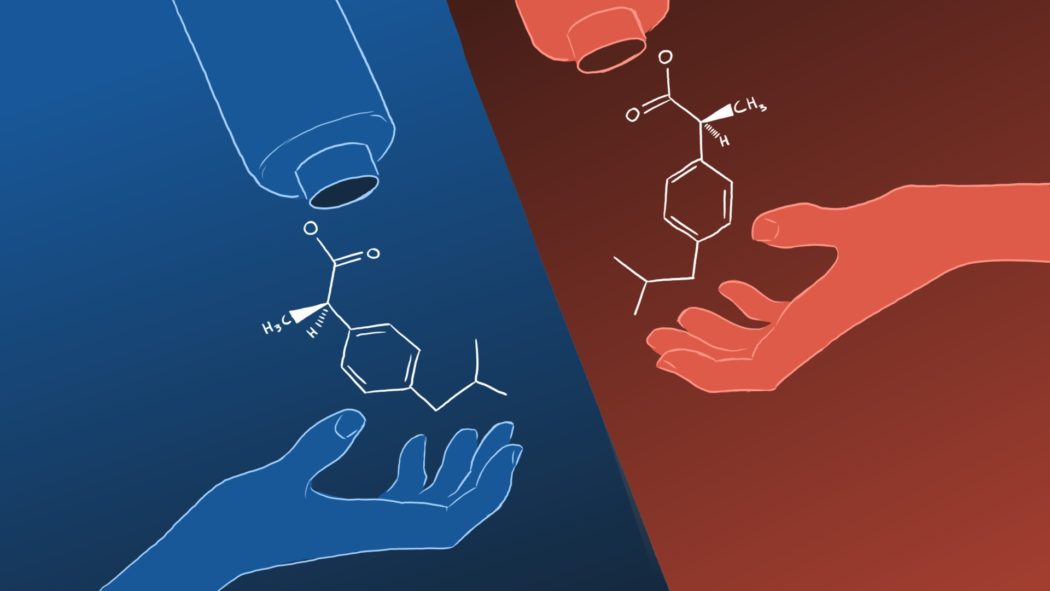Opinion: Mirror, mirror, on the wall: A reflection on pharmaceutical drugs
We live in a world where drugs are more accessible than ever. Many Americans keep ibuprofen or Advil on hand and have experience with some type of prescription drug.
Yet, the normal person knows very little about the drugs they put in their body — and what we don’t know can hurt us.
As an individual, you should be very concerned about anything you ingest, especially if it’s a chemical. Your health will be directly impacted by what you put into your system and how often. So if you’re going to use a drug, you really should know what all goes into it.
Of course there are a lot of components that go into our drugs, but the focus of this article is on enantiomers.
Enantiomers might seem complicated but they’re quite simple. To help you understand enantiomers, take a second to look down at your hands.
Your left and right hands are mirror images of one another. If you reflected your left hand in a mirror, you’d get your right hand, and vice versa. However, even though they are mirror images of one another, your left and right hands are not identical. If you want proof, try fitting your left hand into a right-handed glove.
Similarly, enantiomers are molecules that are non-identical mirror images of one another. Like your left and right hand, they look very similar and are made up of the same stuff. However, they’re extremely different and, more importantly, they cause different reactions in the human body.
To distinguish the two, chemists call one enantiomer (R) and the other (S). Whether you know it or not, enantiomers, both (R) and (S) have been impacting your life for years.
Nearly 65 years ago, the drug thalidomide was approved for sale in Germany and sold over the counter to help pregnant women deal with symptoms of nausea. The producers assured everyone that thalidomide was perfectly safe.
Doctors began to think otherwise when more than 10,000 women who had taken thalidomide during their pregnancy gave birth to children with birth defects.
What people didn’t know or didn’t realize is that thalidomide was being sold as a mixture of two enantiomers — (R)thalidomide and (S)thalidomide. (R)thalidomide helps to alleviate symptoms of nausea. However, its malicious doppelganger, (S)thalidomide, causes a much different reaction in the human body, resulting in birth defects in children.
Thalidomide itself will probably never impact your life, but many other enantiomers will. In fact, over half of the drugs in use today are enantiomers (either (R) or (S)) and of those drugs, 90% are sold as a mixture of (R) and (S). Among these drugs are ibuprofen, ketamine, citalopram and many, many others.
Like with thalidomide, there is usually one enantiomer present in a given drug that has the effect that we want. (As a note, the enantiomer with the desired effect may be either (R) or (S). It depends on the drug.) The other enantiomer either has positive side effects, no effect on the human body, or it causes unwanted side effects.
Whether or not it is beneficial or harmful to sell a drug as a mixture of its enantiomers depends on the drug. With some drugs (such as ibuprofen) selling it as a mixture is more beneficial for you, with others it doesn’t matter, and with still others it can have serious long-term consequences.
The best way to figure out if a drug may have consequences you don’t want because it’s a mixture of enantiomers is to do a little research.
Start by figuring out if the medication you’re considering taking is chiral — this is a fancy way to say that it has enantiomers. If it is, take the time to learn a little about it.
Is the (R) or (S) enantiomer causing the effect you want? Is it sold as a mixture of (R) and (S) or is it a pure enantiomer? If it is a mixture then what is the effect of the other enantiomer? Is it a side effect that you’re ok with? In a world where unlimited knowledge is at our fingertips, all this can be accomplished by a quick Google search.
During this COVID -19 pandemic, your health is more important than ever. Take your health into your own hands and do a little more research about the things you’re putting into your body. When deciding whether or not you should take a drug, take a minute to learn a little bit about what it is that you could be ingesting.

Emeline Haroldsen is a dual Mathematics and Biochemistry major. She’s originally from Maryland and she enjoys most forms of physical activity, playing the piano, and completing her homework on time.
emeline.haroldsen@usu.edu

